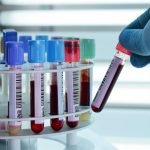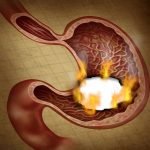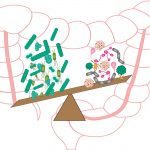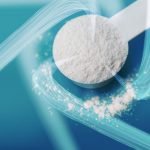An Elemental Primer: Use of Elemental Diets in IBD and IBS – Part 2
Gary Weiner, ND, LAc
Naturopathic Perspective
In Part 1 of this article, I discussed the history, indications, and mechanisms of action of an elemental diet (ED). Part 2 offers prescribing recommendations, tips, and 3 cases demonstrating practical use.
Prescribing the Elemental Diet in 6 Steps
Step 1 – Know the Clinical Objective & Context of Care
Be clear about the therapeutic objective in the context of the patient’s total care, which often includes some conventional treatment. Objectives include induction or maintenance of remission in refractory cases; support of a conventional plan unable to produce complete induction or maintenance; resolution of inflammatory bowel disease (IBD) or irritable bowel syndrome (IBS) undernutrition; management of small intestinal bacterial overgrowth (SIBO) and/or IBS (alone or coexisting with IBD); and/or resolution of a persistently abnormal lactulose breath test (LBT).
Step 2 – Select an Exclusive or Partial ED
In exclusive elemental diets (EEDs), the patient consumes 100% of caloric requirements. In a “partial” or “half-elemental diet” (half-ED), up to half of daily calories (900-1200 kcal) are provided by the ED, and half from whole foods.1 EEDs are selected to induce remission of acute disease, resolve SIBO, or address suboptimal nutrition; half-EDs are selected only to maintain remission. Crohn’s disease (CD) appears to be the sole condition for which a half-ED has been studied; however, it may prove useful for maintenance in other conditions discussed in Part 1.
Step 3 – Calculate Nutritional Requirement
Following Step 2, the clinician determines the BMR, plugging the patient’s height and weight into the Harris-Benedict Equation, then multiplying by an activity factor representing the patient’s exercise pattern. The product of the equation is an estimate of daily calories required to maintain current weight. If the patient has a lot of body fat or a low BMI, necessary adjustments are applied.
Step 4 – Prescribe the Formula – Dosage, Duration, PARQ
Dosage
Dosage is based on total calorie requirements distributed throughout the day. With an EED, I divide total calorie requirement into ~300-calorie servings, consumed every 2-3 waking hours. I find this superior to recommending 3 large “meals.” Each serving must be taken slowly, over 15-30 minutes, which decreases risk of hypoglycemia, hunger, and osmotic diarrhea.
With half-EDs, I divide the total ED calories (half of the daily total) into 300-calorie servings, consumed every 2-3 hours during either the first or second half of the day, according to preference. A whole-foods diet is consumed during the half-day when the ED is excluded. This method allows some bowel rest, which supports gut healing.
Duration
Duration of an ED is flexible and depends on the objective. To induce remission with an EED, 4 weeks was the starting point in many studies. This can be extended if safely monitored.2,3 For repleting malnutrition, I do not see a literature standard. I start with 2 weeks, and follow nutritional markers to determine duration.
For remission or maintenance in IBD with a half-ED, there are no published guidelines. Theoretically, it may be used indefinitely as a nutritional supplement (though its long-term effect on microbiota hasn’t been studied and should be used cautiously). I begin with 1 month, then follow up regularly and assess what degree of ED can maintain either adequate nutritional status or remission from acute disease along with other treatments.
To manage SIBO, a 14-day ED normalized a LBT in 80% of subjects.4 A third week can be added if necessary.
PARQ
I PARQ patients (ie, discuss Procedures, Alternatives, Risks, and answer Questions) at the time the ED is prescribed, communicating key points: strengths and limitations of dietary management; necessary compliance for best results; and follow-up to monitor and troubleshoot. I stress slow feeding and adequate hydration to avoid osmotic diarrhea, headaches, nausea, and/or hypoglycemia.
Step 5 – Monitor the Patient
Physicians need to follow patients for:
- Compliance – Consuming required calories
- Medical and Nutritional Stability – Completing appropriate exams and labs, and monitor weight
- Progress – Assuring that objectives are achieved; in IBD, inflammatory markers (ESR, CRP, fecal calprotectin) and nutritional markers are followed; in IBS with SIBO, LBTs are monitored. Follow-ups will allow time to manage medications, coordinate with other providers, and address obstacles.
Step 6 – Transition to Whole-Foods Diet
Completing an ED is followed by a transition to whole foods. In most cases, returning to an unrestricted diet will not extend improvements gained, and may lead to relapse in either IBD or IBS. Patients are warned that it may take time and considerable dietary therapy to establish a stable remission.
In IBD, I suggest tapering the ED servings over several days while introducing easily digestible foods. I generally follow the guidelines for the “introductory Specific Carbohydrate Diet” (SCD): peeling, de-seeding, fully cooking vegetables, and using simple broths. The degree of restriction and texture modification will depend on the virulence of the disease and how much remission was achieved during the ED. In difficult cases, I consider half-EDs transitionally, if not for longer periods.
In IBS with SIBO, the transition is usually less dramatic than in IBD and will depend on 1) the diet selected from a range of strategies; 2) the patient’s unique intolerances; and 3) the degree of persistent bacterial overgrowth.
Troubleshooting
EDs can present problems, but most have practical solutions:
- Palatability of the ED is the most common obstacle to compliance and success.
- SOLUTION: Find flavored products that taste good. Obtain samples for patients to try. Techniques that improve palatability: blending with ice; diluting with extra water; using carbonated water; adding small quantities of stevia, lemon, lime, vanilla, peppermint, or orange; using a cup, lid, and straw (patients tire of the sight, smell, and mouth-feel of EEDs); try a different product if necessary.
- Cost can be a limiting factor when using an ED for 2-4 weeks, or ongoing with a half-ED.
- SOLUTION: Dr Alison Siebecker offers information on assembling a “homemade” ED formula. Although not studied or FDA-approved, this has produced impressive results.5
- Weight Loss can be expected with an EED. A 3-6 lb loss is common in the first week, usually followed by weight gain with restored nutritional assimilation. However, low BMI should be a caution.
- SOLUTION: Closely follow any patient with low BMI. If weight loss persists, suspect non-responsiveness to treatment; check for diarrhea and vomiting. If this occurs, re-hydrate patient and replace lost electrolytes. Also check for compliance, as weight loss may signify continued undernutrition. Another tip: add fat to the diet (caution in IBD).
- Nausea occurs in some patients, usually when starting an ED. Nausea can also result from inadequate hydration, taking too many supplements, or an ingredient in the formula stimulating this response. It may also stem from too much or too little fat, or too high a load of carbohydrates.
- SOLUTIONS: Add water, reduce or eliminate supplements, use a higher-fat or lower-fat formula, or alter carbohydrate content.
- Hunger & Fatigue from Low Blood Sugar. Hypoglycemia can be exacerbated by consuming the ED quickly. Predisposing adrenal fatigue can lead to low cortisol and hypoglycemia between feedings. Hunger and fatigue may also result from insufficient calories, inadequate fat content, or emotional difficulties. Patients with diabetes present unique challenges, and clinicians should be cautious about using high-sugar formulas.
- SOLUTIONS: Check for caloric compliance, monitor sugars, screen for and treat adrenal insufficiencies, add fat if necessary to increase calories and satisfaction, sip more slowly to avoid abrupt insulin surges and glycemic imbalances, and address psycho-emotional health. Avoid the ED in diabetes.
- Emotional Issues will emerge with the restrictive and – for some – unpleasant regimen. Depressed and anxious patients often manifest intensification of their emotional states. Disordered eating patterns will complicate treatment.
- SOLUTION: Screen for vulnerability. Acknowledge the social interruption of the diet. Reframe the experience. Avoid EDs in patients with eating disorders. Support patients as needed.
- Fungal Overgrowth. Due to the high sugar concentration of EDs, predisposition to fungal conditions or existing overgrowth can complicate treatment, resulting in possible dermatoses, vaginitis, thrush, pruritis, or aggravated abdominal symptoms during treatment. If patients bloat with an ED, they may need antifungal treatment.
- SOLUTIONS: Screen with fungal cultures and candida antibody tests, and treat as needed prior to or concomitantly with initiation of the ED. Or, treat presumptively.
- Constipation. Decreased bowel movements are expected with an ED, given the low residue and proximal absorption of pre-digested nutrients. This is not necessarily problematic.
- SOLUTIONS: Increase the fat content of the diet; use magnesium and vitamin C supplements (but caution for nausea); advise hot water in the morning and before bed; prescribe enemas, glycerine suppositories, or motility agents, as needed.
- Diarrhea & Abdominal Pain. When these symptoms increase with an ED, consider that remission is not being induced. However, osmotic diarrhea is common when patients take the ED too quickly and water is increased in the colon due to the high solute concentration. Increased bloating (and pain) can also be an indication of GI fungal overgrowth.
- SOLUTIONS: Assess for worsening IBD or IBS. Have the patient try diluting the ED and sipping it more slowly, or drinking smaller portions of formula more frequently. Sometimes finding a lower-fat formula can correct diarrhea or abdominal pain. Treat fungal overgrowth if it exists.
A Few Cases
Case #1 – Simple IBS, with SIBO
A 53-year-old male presented with chronic fatigue, poor stamina, constant bloating, flatulence, and belching, and 3-4 urgent, loose stools daily for 5 years, ever since an episode of gastroenteritis. Gluten and dairy-free diets had not helped him.
A LBT demonstrated peak rises of H2 (hydrogen) and CH4 (methane) gases of 49 ppm and 3 ppm, respectively, during the first 120 minutes. The patient was diagnosed with SIBO and treated with 2 evidence-based, encapsulated, anti-bacterial products containing a mixture of herbs (2 capsules of each in AM and PM); an herbal prokinetic product; and a SIBO-specific diet combining a SCD and Low-FODMAPS diet.
Four weeks later, a repeat LBT demonstrated peak rises of H2 and CH4 gases of 47 ppm and 4 ppm, respectively, and no improvement in symptoms. The patient was treated with rifaximin (550 mg, 1 tablet 3 times/d for 14 days), in conjunction with a SIBO-specific diet.
Four weeks later, there was still no improvement in symptoms, and a repeat LBT demonstrated peak rises of H2 and CH4 gases of 48 ppm and 12 ppm, respectively.
Finally, the patient completed a high-fat/low-carbohydrate “Homemade” ED for 2 weeks. Four weeks later, a repeat LBT demonstrated peak rises of H2 and CH4 gases of 4 ppm and 0 ppm, respectively.
COMMENT: By reducing bacterial overgrowth via a different mechanism than antimicrobial agents, the ED can often be an efficacious intervention in antibiotic-resistant cases.
Case #2 – Complex, Refractory IBD
A 35-year-old male presented with steroid-dependent, refractory ileocolonic CD with colonic stricturing, through which a colonoscope could not pass. He was unresponsive to conventional treatments and was now exploring integrative care before undergoing total colectomy. He was on prednisone taper (to 5 mg/d) with breakthrough IBD symptoms, including 4-5 urgent bowel moments daily, bristol stools #7, moderate abdominal pain, and joint pains that were extraintestinal manifestations of active CD. Fecal calprotectin was >2000 µg/g (normal = <50). A LBT displayed peak rises of H2 and CH4 gases of 25 ppm and 1 ppm, respectively.
He started a 3-week EED, followed by a slow phasing-in of the SCD; however, he abandoned the EED at 1 week due to “taste” and “hunger,” then self-implemented phase 1 and 2 of the SCD. He noted that abdominal pain, joint pains, and stool normalized at 2 weeks. At 4 weeks, a fecal calprotectin was measured at 531 µg/g, and a follow-up colonoscopy at 8 weeks showed improvement in mucosal inflammation such that a colonoscope could pass. Over the course of 6 months, with difficulty maintaining compliance with the SCD, the patient’s fecal calprotectin rose to 942 µg/g; after a 1-week ED was commenced, the fecal calprotectin dropped to 432 µg/g. The patient then used a half-ED (600-900 calories/d, with the remaining calories as SCD) for 1 month. At that point, his fecal calprotectin measured 167 µg/g and he had no symptoms of IBD.
Currently, at 12 months of care, the patient is maintained – in conjunction with his conventional plan – on intermittent, pulsed use of a half-ED, along with the SCD. The referring gastroenterologist agrees that as long as inflammation is kept “low” and the patient is properly surveilled, colectomy can be avoided.
COMMENT: In refractory cases of IBD like this one, both the EED and the half-ED are extremely useful tools in dietary management.
Case #3 – “IBS within the IBD”
A 28-year-old male presented with left-sided ulcerative colitis x 10 years. He was on 4.8 g/d of mesalamine and an exclusion diet of gluten and dairy products. For 2 months, he had 5-6 unformed bloody stools daily, with abdominal pain, bloating, and foul flatulence that had intensified during the prior 2 weeks of work stress. He and his primary care physician believed he was flaring, and he received a prednisone prescription, which he postponed filling due to a historical intolerance. An anoscopic exam displayed internal bleeding hemorrhoids and an otherwise unremarkable rectum. Labs revealed a fecal calprotectin of <15 µg/g, an ESR of 3.8 mm/hr, CRP of 1.4 mg/dL, and a LBT demonstrating peak rises of H2 and CH4 gases of 76 ppm and 23 ppm, respectively.
Given the normal IBD biomarkers, and a LBT indicating SIBO, the patient completed a manufactured low-fat ED for 14 days. He also submitted breath samples, which showed peak rises of H2 and CH4 gases of 28 ppm and 15 ppm, respectively. He continued the ED for 1 additional week and we ran another LBT on Day 22, which displayed peak rises of H2 and CH4 of 3 ppm and 1 ppm, respectively. He transitioned to a SCD and the prokinetic, naltrexone (4.5 mg before bedtime), and initiated a stress reduction plan that included botanical adrenal support, meditation, and acupuncture. He has remained in remission of both IBS and IBD for 8 months, while also lowering his mesalamine to a maintenance dose of 2.4 g/d.
COMMENT: SIBO frequently exists within IBD and can cause signs and symptoms easily confused with active disease.6 Given the ED’s ability to “serve 2 masters,” it can be a useful intervention for addressing dysbiosis along the entire continuum between IBS and IBD.7
References:
- Takagi S, Utsunomiya K, Kuriyama S, et al. Effectiveness of an ‘half elemental diet’ as maintenance therapy for Crohn’s disease: a randomized‐controlled trial. Aliment Pharmacol Ther. 2006;24(9):1333-1340.
- Esaki M, Matsumoto T, Hizawa K, et al. Preventive effect of nutritional therapy against postoperative recurrence of Crohn disease, with reference to findings determined by intra-operative enteroscopy. Scand J Gastroenterol. 2005;40(12):1431-1437.
- Harries AD, Jones LA, Danis V, et al. Controlled trial of supplemented oral nutrition in Crohn’s disease. Lancet. 1983;1(8330):887-890.
- Pimentel M, Constantino T, Kong Y, et al. 14-day elemental diet Is highly effective in normalizing the lactulose breath test. Dig Dis Sci. 2004;49(1):73-77.
- Siebecker A. Homemade Elemental Diet: Low Carb / Higher Fat Option. Available at: http://www.siboinfo.com/uploads/5/4/8/4/5484269/homemade_elemental_diet_options.pdf. Accessed October 14, 2017.
- Klaus J, Spaniol U, Adler G, et al. Small intestinal bacterial overgrowth mimicking acute flare as a pitfall in patients with Crohn’s Disease. BMC Gastroenterol. 2009;9:61.
- Bercik P, Verdu EF, Collins SM. Is irritable bowel syndrome a low-grade inflammatory bowel disease? Gastroenterol Clin North Am. 2005;34(2):235-245, vi-vii.
Image Copyright: <a href=’https://www.123rf.com/profile_bee32′>bee32 / 123RF Stock Photo</a>
 Gary Weiner, ND, LAc, practices at Pearl Natural Health in Portland, OR, where he treats patients with GI disorders and has developed an alternative and complementary care program for inflammatory bowel disease. He graduated from NCNM in 1997 and completed a 1-year residency in family medicine. He served as a clinical supervisor at NUNM through 2016, and offers an NUNM-certified residency program sponsored by the National Education and Researched Consortium (NERC). He is a member of the GastroANP, and has served on the medical advisory board of the Northwest Crohn’s and Colitis Foundation of America. Dr Weiner lives in Portland with his wife and daughter.
Gary Weiner, ND, LAc, practices at Pearl Natural Health in Portland, OR, where he treats patients with GI disorders and has developed an alternative and complementary care program for inflammatory bowel disease. He graduated from NCNM in 1997 and completed a 1-year residency in family medicine. He served as a clinical supervisor at NUNM through 2016, and offers an NUNM-certified residency program sponsored by the National Education and Researched Consortium (NERC). He is a member of the GastroANP, and has served on the medical advisory board of the Northwest Crohn’s and Colitis Foundation of America. Dr Weiner lives in Portland with his wife and daughter.









